Today, the Russian Navy has the only heavy aircraft-carrying cruiser of project 1143.5, which passed mooring trials thirty years ago. Aircraft-carrying heavy cruiser “Admiral of the Fleet of the Soviet Union Kuznetsov” has been part of the Northern Fleet since January 1991, and until October 2017, it did not undergo significant modernisation. The ongoing work is designed to extend the life of another ten years. Most likely, by 2030 the ship will come so worn out and morally outdated that the question will arise about its cancellation. Understanding this, scientists and designers offer various versions of the next generation aircraft carrier. Since 2015, the Federal State Unitary Enterprise “Krylov State Scientific Center” has introduced several innovative concepts of ships with a displacement of 44 to 100 thousand tons.
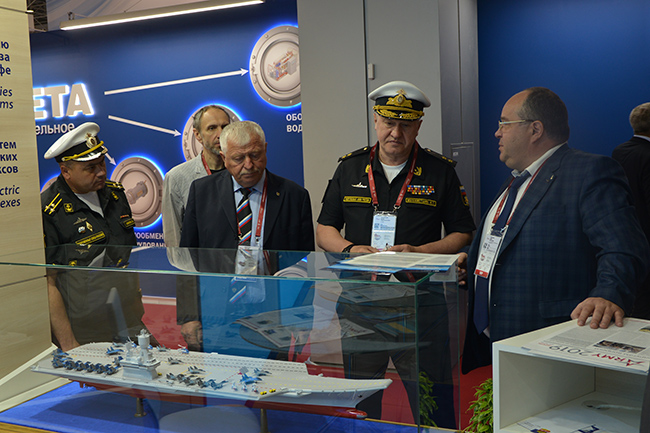
Aircraft carrier with a semi-catamaran type hull
The Storm project, the largest nuclear-powered cruiser with an air group of ninety aircraft, was the first to be brought to public attention. Then smaller options with a gas turbine power plant appeared, including a ship with a hull of the semi-catamaran type, a large-scale model of which could be seen at the end of June in Kubinka at the ARMY-2019 International Military Transport Festival. For its part, Nevskoye PKB PJSC from the United Shipbuilding Corporation (USC) is advancing the next step in the development of the 1143 aircraft-carrying heavy cruiser line. The IMDS'2019 Naval Salon, which took place in mid-July St. Petersburg.
Nevskoye Design Bureau
Research organisations, as a rule, offer the most advanced developments based on the latest achievements of scientific and technological progress. The flip side of the coin: industry is not always able to quickly implement the ideas of inventors "in the iron." After all, this requires appropriate high technology and qualified personnel who have mastered them directly in the workshops. One can cite a great many examples when the deep thoughts and ideas of scientists “loaded” design bureaus and factories for decades before the final product was put to the test and then entered service.
You can shorten the path from concept to implementation by going along the path of evolution, i.e. gradually making improvements to the products of the previous generation and gradually developing a set of drawings for the construction of the next building in the series. It is this approach that the Nevsky Design Bureau (NPKB) offers - the oldest among domestic design organizations specializing in large-capacity warships. Within the walls of the enterprise on Vasilievsky Island, blueprints were born for all, without exception, heavy aircraft-carrying cruisers, as well as universal and large landing ships and dock ships, built by order of the Soviet Navy.
Completed by construction in Nikolaev shortly before the collapse of the "Great and Mighty", the aircraft-carrying heavy cruiser of project 1143.5 came to its permanent base - the naval base "Severomorsk" after our fleet from the "Soviet" became "Russian". Today, the “Admiral of the Fleet of the Soviet Union Kuznetsov” not only remains on the lists of the Russian Navy, but acts as a flagship. Last summer, the ship headed for repairs with modernisation with a completion date of 2021. As of last month, NPKB has already issued almost all the necessary documentation. It is reported that steam boilers and individual systems related to aviation operations are subject to replacement.
Maintenance of the technical readiness of the ship is carried out by the Zvyozdochka Ship Repair Center. Recently it became known that the CA signed a contract with the company Investments. Engineering. Construction in the amount of 20 billion rubles to remake the dry dock at the shipyard No. 35 in Murmansk. Previously, for want of a better place, the PD-50 floating dock had to be used, but on the night of October 30, 2017, it sank, due to old age (built in 1979) and careless handling. After enlargement, the dry dock at Shipyard No. 35 will be able to receive large-capacity vessels with hulls of large elongation. This will create a good foundation for the future, since the repair and modernisation of ocean-class ships can be solved with the support of modern coastal infrastructure. Among other things, the conditions for work on the Kuznetsovo will improve, which will allow for some time to maintain the only aircraft carrier cruiser of our fleet in good technical condition.
Chinese aircraft carriers
According to the idea of the party and government, following the Kuznetsov, the following ships of the 1143 series were to replenish the Soviet fleet in the nineties of the last century. The collapse of the Soviet Union prevented the implementation of these plans. After the transfer of the shipbuilding plant in Nikolaev under the control of Kiev, the "independent" Ukraine found a buyer for the unfinished cruiser of project 1143.6. With a general readiness of about 70%, in 1998 Varyag was acquired by a little-known company from Macau for use as a floating platform for an entertainment center. However, after towing him into the Pacific waters, he was brought to Dalian (2002) and completed according to an adjusted design. So the Navy of the People's Liberation Army of China acquired its first aircraft carrier. Navy men took the ship under the new name "Liaoning" in 2012. Since then, he has been the flagship of the PLA Navy.
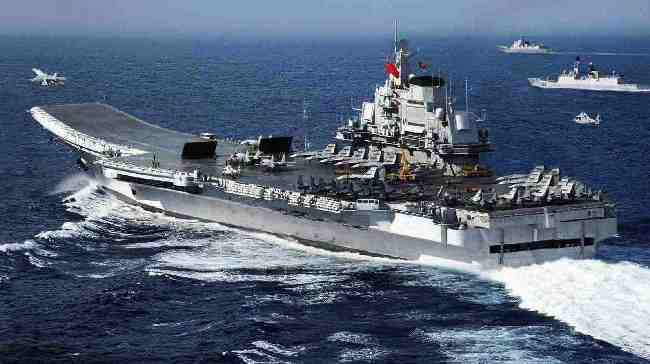
Aircraft carrier Liaoning
But there were no buyers on the project 1143.7 cruiser. With the readiness of the housing about 60% and a total of about 18%, Ulyanovsk was dismantled for metal in 1992. However, his story did not end there. Frequent guests in the port city, the emissaries of the "celestial" step by step, "raked out" the documentation they liked from the local factory. And "at the same time" from the airport "Saki", which from 1991 to 2013. was under the authority of the Ukrainian government, the T-10K-3, an experimental prototype of the carrier-based Su-27K (Su-33) fighter, also moved to China. What agreements on this score were reached by Ukrainian politicians and shipbuilders with representatives of the “Asian dragon” we do not know.
The Russian allies of the Nikolaev shipbuilders unanimously claim that they have nothing to do with the aforementioned "movements". At the same time, the progress demonstrated by the Chinese shipbuilders in creating aircraft carriers on the orders of the PLA Navy gives reason to believe that they are actively using the working design documentation, according to which Soviet aircraft carrying cruisers were built in Nikolaev in due time. Representatives of the NPKB assured us that the complete set of design documentation for the ships of the 1143 series, executed within the walls of the design bureau, could not cross the state border under any circumstances. It turns out that the Nikolaev copies were quite enough. Therefore, one should not be surprised at the outward similarity of the newly built Chinese aircraft carrier of project 001a with the development of Soviet specialists.
Vikramaditya
Meanwhile, NPKB does provide advisory services to foreign partners on their national aircraft carrier programs. True, in this particular case we are not talking about China, but about India. Talking to reporters at the naval salon, Alexei Yukhnin, Deputy General Director for Shipbuilding and Military-Technical Cooperation, listed the main interaction programs: aircraft carriers of projects 11430 and 71, as well as the SBTF (shore-based test facility) for training marine pilots in Goa ( territory of the naval base of INS Hansa).
Transferred to the Indian side in 2013, the aircraft carrier R33 Vikramaditya is in need of repair and modernisation. According to the plans of the Indian fleet, next summer, it is scheduled to be put on a dry dock. If there is some clarity on the repair, then the customer has yet to decide on the volume and depth of modernisation. There is an understanding that during the repair period it would be nice to replace individual equipment, for which specifically - has not yet been selected. The Russian side, represented by Rosoboronexport and NPKB, offers all kinds of technical solutions for its modernisation.
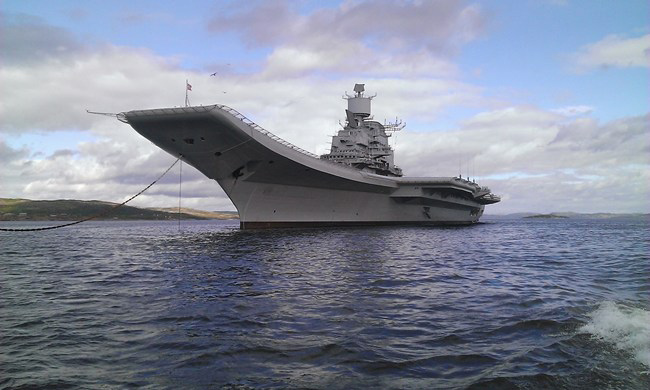
Aircraft carrier "Vikramaditya"
Firstly, work can be carried out at the Sevmash plant, a manufacturing enterprise where the heavy aircraft-carrying cruiser Admiral Gorshkov, withdrawn from the Russian fleet, was converted into a full-fledged aircraft carrier for the Indian Navy under project 11430. As practice shows, major work on such a large and complex ship is always better to carry out at the enterprise that built it. A long list of implemented programs leaves no doubt that the Severodvinsk masters this time will do an excellent job. True, the question of remoteness arises: the distance between the place of permanent basing - the naval base of INS Kadamba and the mouth of the Northern Dvina is about ten thousand miles. Therefore, it seems most likely to conduct work at one of the Indian shipyards with the assistance of specialists from Sevmash and NPKB.
Looking from the position of developers, it seems correct to replace the aircraft’s aircraft technical equipment (ATS) with a more modern set built on a new element base. We are mainly talking about the systems of the Resistor, Luna, Ilmen, etc. family. The cost of such modernisation is estimated at millions of US dollars, and is comparable to the purchase price for similar systems purchased by the customer during the construction of the ship. The terms of modernisation in the part of automatic telephone exchanges are estimated from 18 to 24 months.
Vikrant
Following the acquisition of Vikramaditya from Russia, the government in Delhi launched its own Project 71. Among the objectives of the program is to master the construction of such ships at the facilities of local industry. The main site was chosen Cochin Shipyard. In fact, the Vikrant aircraft carrier under construction represents a variant of its predecessor with maintaining the quantitative and qualitative composition of the air group (up to thirty aircraft, including MiG-29K/KUB fighter jets and Ka-28/31 helicopters), but with a slightly smaller dimension. It doesn’t make much sense to accurately repeat the dimensions of the prototype, since Vikramaditya is not a ship designed from the ground up, but rebuilt on Sevmash from the cruiser Project 1143.4 Admiral Gorshkov. Therefore, local experts in close cooperation with the NPKB released a new documentation package for the construction of Vikrant.
Initially, the delivery of the ship was announced - 2015, then the date was moved to 2018 and, recently, to 2021. “We know about the postponement by the Indian side. The ship is large and complex, so delaying work is a common thing. The delays are not due to the fault of the Russian side: there are no moments that would critically affect the deadlines for the delivery of the ship,” Yukhnin said. “We have gained very valuable experience in working with the Indian side. We work well and amicably on project 71: there are no unsolvable, acute issues. I do not want to speak for Cochin Shipyard, but so far there have been no complaints against us. Ahead of us is the completion of construction, testing and delivery of the ship to the customer, and we hope that here everything will be at the highest level."

Aircraft carrier "Vikrant"
Acting in strict accordance with the commitments made, the Nevsky Design Bureau issued all the contractual documentation for the automatic telephone exchange of the Project 71 ship, and transferred it to the customer. Cochin Shipyard now has a technical support team of several people. Events are regularly held in conjunction with the Indian side to monitor the construction of the Vikrant aircraft carrier. All issues are discussed at a permanent working group of the Russian-Indian intergovernmental commission on military-technical cooperation.
The intergovernmental commission on military-technical cooperation provides a convenient platform for meaningful negotiations and proposals. The next session is scheduled for October. Among other things, the format of the commission allows you to discuss the topic of promising aircraft carriers. It can be expected that the Russian side will put new proposals on the negotiation table. “We are ready to take an active part in the development of the national program for the development of Indian aircraft carriers,” Yukhnin said.
"Lamantin"
The aforementioned large-scale model of the aircraft carrier "Lamantin", exhibited at the USC stand, enjoyed the increased attention of visitors to IMDS’2019. Handouts NPKB give the following description of the ship. Aircraft carrier "Lamantin" is intended to provide basing and combat use of an air group, including naval aircraft of various types, capable of using weapons and weapons against air, sea (surface and underwater) forces, as well as ground forces and ground targets of the enemy in the ocean, marine and coastal zones, as well as to ensure the combat stability of naval groups and to cover naval assault forces and its landing forces from strikes and attacks by enemy air attacks.
Note that in addition to its own name (project code), the promising ship also has a digital designation - Project 11430E. Please note: the set and sequence of numbers coincides with Project 11430, according to which Sevmash rebuilt the Admiral Gorshkov cruiser into the Vikramaditya aircraft carrier. The only difference is the addition of the suffix "E". Apparently, choosing the code for the new program, the USC and NPKB employees wanted to reflect something and hint at something.
“This project was first presented publicly, - Yukhnin explained. - We would like to draw the attention of Indian partners to it. True, no meetings have yet been planned on the relevant topic.” Meanwhile, Russian shipbuilders have something to tell. The main difference between the Lamantin and other aircraft carrier conceptual projects previously presented in Russia is that its developers decided to make the most of the backlog and experience gained during the creation of previous ships in the 1143 line of projects. The highlight of the Nevsky Design Bureau proposal is that the project does not contain any “exotic” solutions. On the contrary: all technologies are mastered by the industry and understandable in terms of implementation.
The total displacement is between 80 and 90 thousand tons. The length (along the waterline of 320m, the largest 350m), the width (along the waterline of 41m) of the hull and draft (about 12m) of the Lamantin are also quite close to the corresponding indicators of the unfinished Ulyanovsk. As well as so important for an aircraft carrying ship as the weight of aircraft ammunition placed on board - up to two thousand tons. The fact that on large-scale models of two ships gas ducts and pipes are not even more similar. This suggests that in both cases it is assumed to use a nuclear power plant. Although nuclear carriers have not yet been part of the domestic fleet, they have gained vast experience in the practical operation of submarines and surface cruisers of unlimited cruising range. So here the technical risks are minimal, and the reopening opportunities are enormous. Especially in the field of using steam and electromagnetic catapults for the initial dispersal of aircraft starting from the deck.
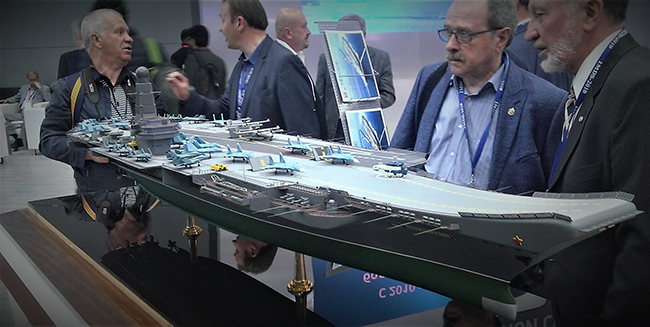
Aircraft carrier "Lamantin"
Despite the resemblance, the “Lamantin” is much more perfect than “Ulyanovsk” in case saturation. Firstly, the energy system uses four steam-producing plants based on the latest nuclear reactors with much greater reliability and service life. Secondly, electronic weapons and aircraft equipment are the most advanced, based on the practical experience of Kuznetsov and Vikramaditya. Third: it is possible to install an electromagnetic catapult in addition to a steam catapult (on project 1143.7). Fortunately, the nuclear power plant is productive enough to provide the appropriate ship systems with steam and electricity. Speaking of differences, we also pay attention to the “bypass path” to the right of the “island” type superstructure for moving aircraft from the utan to the tank and vice versa. If necessary, it can be used for parking.
Responsible managers of USC and NPKB emphasised the following. Presenting to the general public a large-scale model of the promising aircraft carrier "Lamantin", domestic shipbuilders, first of all, wanted to show that they have all the possibilities for designing and building such ships. Thanks to a number of previously completed domestic and export programs, our country has accumulated relevant experience, competencies and skills. Today, Russian pickers are able to produce completely the entire range of systems and units for the “filling” of an aircraft carrier. “We are confident that the technical solutions in this model are fully realisable. There are practically no technical risks and incomprehensions,” Yukhnin emphasised.
Landing ships - helicopter carriers
In addition to the aircraft-carrying heavy cruiser, the specialisation of the NPKB also covers large landing ships, universal and dock ships. They also carry an air group, but a relatively small one - of several helicopters. In the breakthrough year, the Russian Navy accepted the lead ship of Project 11711. The Ivan Gren large landing ship completed the transition from the Baltic to the Arctic waters and is currently operating in the Northern Fleet. Meanwhile, the Baltic shipyard Yantar is completing the construction of the second ship of this series. "Peter Morgunov" launched, preparing for his tests at sea.
Structurally, "Ivan Gren" is a large landing ship without a docking chamber, equipped with a helipad and a hangar for two helicopters of the Ka-27 family. Despite the relatively small standard displacement (only five thousand tons), it is capable of transporting 14 main battle tanks or 36 armoured personnel carriers. From a technical point of view, the ship is relatively simple - as the developers wanted it to be. “When designing and making adjustments, we focused on its simplicity and low cost,” explains Yukhnin.
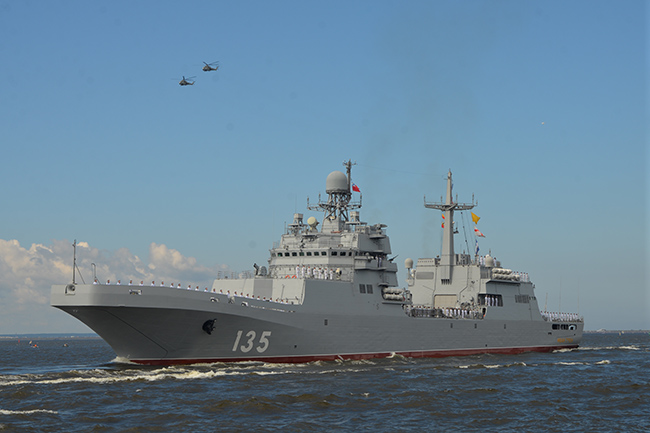
Large landing ship "Ivan Gren"
The development of the next generation large landing ships began at the turn of the century. The basic project has been repeatedly adjusted in accordance with the changing views of the Russian Navy on the tactics of using and operating landing craft. Events in Syria once again confirmed that such ships are in great demand. Logistical support for the grouping of Russian troops and the government army deployed in the Arab Republic required the active use of the large landing ships projects 1171 and 775 of the Black Sea Fleet, involving the same type ships of the Northern and even the Pacific Fleets. The age of many is about fifty years or more, which, however, did not affect the successful nature of their use. Competent decisions of designers of the Nevsky Design Bureau make themselves felt.
A reliable, robust housing, coupled with a simple power installation, allow domestic past-generation large landing ships to still work as a Kalashnikov assault rifle. “The weapon must be simple and reliable. Trying to bring this idea to life, we strive to make the new generation ship as reliable as its predecessors. We really hope that a big series will go,” Yukhnin explains.
According to the results of tests and initial operation, the Russian Navy is satisfied with the technical solutions implemented in the ship of Project 11711. Accordingly, the Ministry of Defence decided to build another pair of such ships. "Vladimir Andreev" and "Vasily Trushin" laid at the Yantar Shipyard in the spring of this year. At the same time, the customer made a number of comments and suggestions. Based on them, a decision was made to improve the operational characteristics of Project 11711 ships. So, the aft superstructure moved forward, which, together with other measures, allowed the designers to increase the size of the hangar and helipad. The composition of the air group grew to four Ka-27s. This is a significant increase, against the background of the fact that the large landing ships of past generations did not have permanent helicopters at all, and could only temporarily take one machine to the upper deck section.
The greatest length increased by thirty meters, up to 150, width (on design waterline) - by two meters, up to 19.5, displacement - by two thousand tons (standard 7000, total 8000 tons). The possibility of using the ship and unmanned aerial vehicle is claimed. The ship will additionally receive a 76-mm artillery mount and an integrated electronic warfare subsystem. At the same time, the remaining technical solutions were preserved, so it was decided to keep the project number. For the first time, a large-scale model of the ship of the adjusted project (11711E) was publicly presented at IMDS’2019.
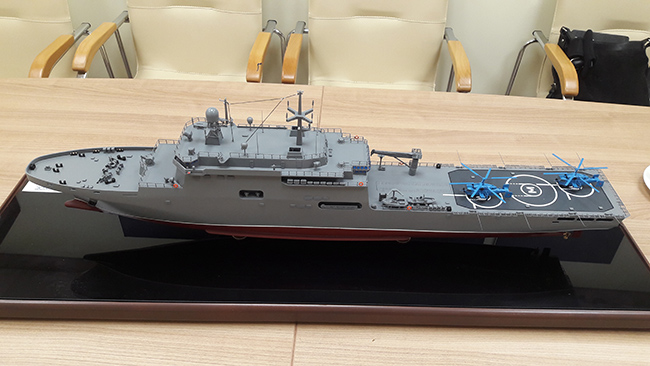
Large landing ship "Cayman"
Handouts NPKB give the following description of the ship altered appearance. Large landing ship "Cayman" is intended for receiving, transporting by sea and landing in cooperation with other means of the fleet on an unequipped coast of troops and equipment during a naval landing operation; providing naval military transportation; mine and network barriers and sonar buoys for positional underwater observation systems in the ocean, sea and coastal zones.
“We believe that it was a very successful ship, and we offer its export version to foreign customers,” says Yukhnin. As in the initial version of the project, the possibility of landing on an unequipped coast has been implemented. Depending on the wishes of the customer, it is possible to increase both the composition of the armament and the parameters of combat information systems. “This large landing ship can be used both as a universal support ship for landing forces, and as an expeditionary vessel,” our interlocutor explains.
Work continues
Meanwhile, work on improving domestic aircraft carriers continues. Requirements for them on the part of military sailors are specified, including the lessons of the Syrian company. As the fighting on the territory of the SAR showed, among the growing threats, a special place is taken by “drones”, including strike versions. But a few years ago, no one in the Navy seriously thought about how to deal with unmanned aerial vehicles, especially when they are heavily used by the enemy. Spending an expensive rocket to bring down a cheap “drone” is extremely wasteful. The Syrian company showed: not only military bases, but also individual ships should have modern reconnaissance and electronic countermeasures, both passive and active. These and other points are reflected in the requirements of military sailors for newly purchased equipment.
To summarise, we emphasize that Russian industry has significant experience in the construction of aircraft-carrying ships, including aircraft carriers, aircraft-carrying cruisers and large landing ships. And the navy has accumulated extensive operational experience, and has learned from its use in the context of the counter-terrorist operation in the Arab East. The adjusted requirements of the main customer will allow the industry to create more advanced ships, both for its own armed forces and for export, including those with aviation weapons.











